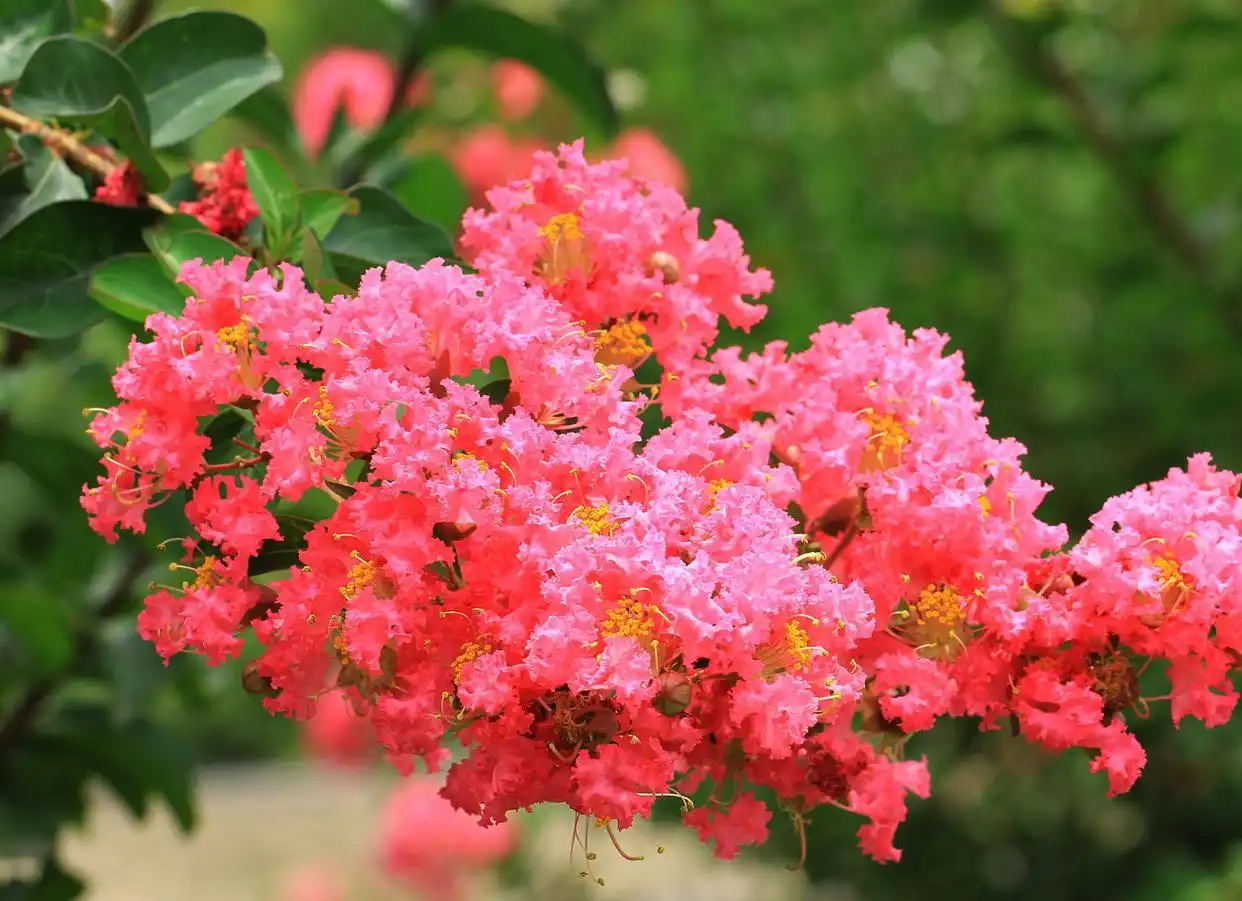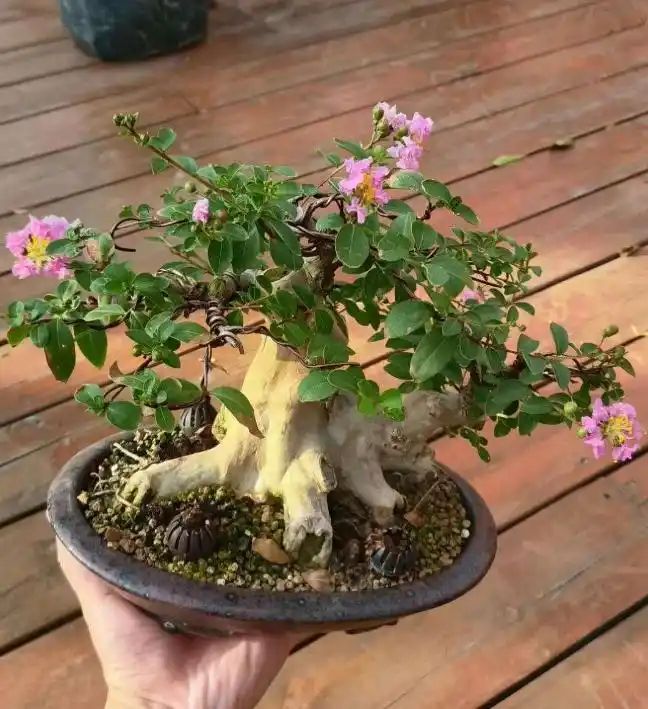Crape myrtle have strong adaptability, but scientific maintenance can significantly improve their ornamental effect and growth health. The following is a systematic explanation of the key points for the maintenance of crape myrtle flowers from the dimensions of soil, light, water, fertilization, pruning, pest control, and special maintenance:

1. Soil management: equal emphasis on breathability and nutrition
1. Soil selection
crape myrtle flowers prefer loose, fertile, well drained sandy loam or humus soil, with a pH value ranging from neutral to slightly acidic (6.0-7.5). Avoid using sticky or compacted soil to prevent root rot.
2. Soil improvement
? Potted plant: Mix humus soil, garden soil, and river sand in a ratio of 3:2:1, and add a small amount of bone meal or organic fertilizer as the base fertilizer.
.? Ground planting: Before planting, deeply plow the soil and mix it with decomposed compost or manure to improve soil structure.
.3. Regularly change soil
Potted crape myrtle should be changed every 2-3 years, with new soil and aged roots trimmed to promote new root growth.
.2. Light and temperature: prefers light and cold resistance, avoiding extreme conditions
1. Light requirements

Crape myrtle are strongly positive plants and require direct sunlight for at least 6-8 hours per day.
. Insufficient light can lead to poor flower bud differentiation, reduced flowering, or dull flower color.? Indoor maintenance: Place it on the south facing balcony or window, and in summer, it can be shaded appropriately (30% shading rate) to prevent blade burns.
? Ground planting: Choose sunny and open areas to avoid being blocked by tall buildings.
2. Temperature control
? Suitable range: suitable temperature for growth is 15-30 ℃, and can withstand low temperatures of -10 ℃ in winter (cold prevention is required in northern regions).
.? Wintering management: In northern regions, ground planted crape myrtle can be covered with straw or plastic film at the roots, and potted plants can be moved indoors (0-5 ℃) to sleep and avoid frostbite.
.III. Moisture Management: When the surface soil is dry, water it until it becomes wet, and avoid standing water
1. Watering Principle
Follow the principle of "when the surface soil is dry, water it until it reaches the bottom drainage hole and water out.
.? Lifetime (spring and summer): water every 2-3 days, and add spray for moisturizing when it is hot and dry.
? Flowering period (summer and autumn): Keep the soil slightly moist and avoid drought causing flower drop.
. Winter dormancy period: Reduce watering, 1-2 times a month is sufficient.2. Drainage Measures
? Potted plants should use pots with good drainage holes to avoid water accumulation at the bottom of the pot.
.? When planting on the ground, gravel or ceramic particles should be laid at the bottom of the planting hole to enhance drainage.
Fourth, Fertilization Management: Apply thin fertilizer frequently and supplement in stages
1. Base fertilizer
Before planting, mix mature organic fertilizer (such as cow manure, chicken manure) or slow-release compound fertilizer (N-P-K=15-15-15) in the soil, with 50-100 grams per plant.
.2. Fertilization strategy
? Early growth stage (March April): Mainly use nitrogen fertilizer to promote branch and leaf growth, and apply urea or high nitrogen compound fertilizer (N-P-K=30-10-10) once a month.
.? Flower bud differentiation period (May June): Increase the application of phosphorus and potassium fertilizers (such as potassium dihydrogen phosphate), and spray foliar fertilizer once a week to promote flowering.
.
? Flowering period (July September): Stop applying nitrogen fertilizer and switch to phosphorus and potassium fertilizers to extend the flowering period.
.? After flowering (October): Apply a decomposed organic fertilizer once to supplement nutrients and enhance overwintering ability.
.3. Fertilization taboos
? Avoid burning roots with concentrated fertilizer, and immediately dilute with water after fertilization.
. Stop fertilizing during the winter dormancy period.Fifth, pruning and shaping: control the plant shape and promote flowering
1. Pruning time
? Dormant period pruning: after falling leaves in winter and before sprouting in spring, cut off dead branches, diseased branches, crossed branches, and inward branches, retain 3-5 main branches, and form an open crown.
.? Long term pruning: Timely remove residual flowers and overly dense branches after flowering to promote new branch germination and secondary flowering.
.2. Pruning method
? Shortening: Shrink the excessively long branches by 1/3-1/2 and control the plant height.
.? Pruning: Remove weak and diseased branches to improve ventilation and light transmission.
? Styling: Trim into spherical, umbrella shaped, or layered shapes according to needs to enhance ornamental value.
1. Flower Promotion Techniques
? Water Control and Flower Promotion: Reduce watering appropriately one month before the flowering period to create mild drought stress and promote flower bud differentiation.
.? Ring peeling promotes flowering: For plants with excessive growth, strip 0.5-1cm wide bark from the main branch to block nutrient uptake and concentrate flower supply.
.2. Bonsai maintenance
? Choose shallow pots, based on the principle of "small pots, big scenery", highlighting the beauty of the root system.
.? Regularly pick and control branches to maintain a compact tree shape.
? Keep warm in winter and avoid root frostbite.
3. Planting Management
? The diameter of the planting hole should be 30 centimeters larger than the soil ball, and the depth should be level with the ground at the root neck.
.? After planting, water the roots thoroughly and cover them with plastic film to keep them moist.